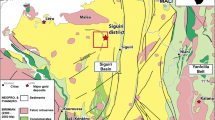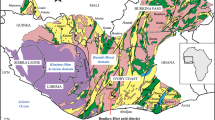Abstract
The vein-type gold deposits of middle to late Archean age constitute one of the major sources of gold production in the world. These deposits are highly diverse in character, but are invariably found in proximity to mafic and ultramafic volcanic rocks, and closely associated with tectonically disturbed zones, or ‘breaks’, in the ancient crust. Using the Larder Lake ‘break’ of northern Ontario and Quebec as a model, a general theory of genesis for such deposits is proposed.
The Larder Lake ‘break’ is of linear configuration, up to four miles wide, and extending over a distance of approximately 150 miles. Many rich and extensive vein-type gold deposits are associated with it. This ‘break’ is recognized as a highly folded and faulted, dominantly sedimentary stratigraphic unit, formed as part of the development of the Blake River geosyncline of the Abitibi greenstone belt. Faulting is pervasive within the ‘break’ but it is non-continuous.
Under an oxygen-poor, somewhat acidic weathering regime believed extant in Archean time, gold and associated constituents, derived as weathering products from mafic and ultramafic volcanics, appear to have been concentrated as solutions and sols in muddy surficial accumulations along a paleo-continental margin. On transfer to a shallow marine environment, the gold-bearing solutions became concentrated mainly as cherty and pyritic evaporitic residues. These residues, infolded and variably metamorphosed and remobilized during ensuing geosynclinal development, formed the numerous and apparently heterogeneous gold deposits of the Larder Lake ‘break’.
Mode of redistribution of gold-bearing residues and metamorphism of their host rocks varies widely. In mild form, little vein development is present and original sedimentary features of the host rock are often preserved. In more extreme cases, true hydrothermal veining is evident and complete recrystallization of the host rock has taken place, sometimes to the extent of formation of a melt with intrusive capabilities. In any case, the gold and related vein constituents remain closely associated with the primary host material and alteration effects are largely derived from the recrystallization of original host rock constituents.
The suggested mode of genesis clarifies the relationship between various types of ‘break’-related, vein-type gold deposits and offers an explanation of the complex stratigraphy and structure of the ‘break’ environment. It also suggests a penecontemporaneous relationship between the Larder Lake ‘break’ and other auriferous ‘breaks’, of varying configuration, within the Superior Province of the Canadian Shield. The concept can be used advantageously in exploration for new ‘breaks’ and new deposits.
Similar content being viewed by others
References
Audet, A.J.: Les mines Sigma (Québec) Limitée; CIM Geol. Div. Gold Symposium Guidebook, 1980, pp. 44–51 (1980)
Baker, J.W. and Staff: Kerr Addison mine; Struct. Geol. Can. Ore Deposits, Can. Inst. Mining Met. Congress Vol., pp. 392–402 (1957)
Bedard, P., Imbeau, G.: Compagnie Minière Lamaque 1964 Limitée; CIM Geol. Div. Gold Symposium Guidebook, 1980, pp. 52–60 (1980)
Bouchard, M.F.: Region de Cadillac-Malartic; Min. Nat. Res. Québec, Rapport Inter. DPV-683 (1979)
Buffam, S.W., Allen, R.B.: Chesterville mine; Struct. Geol. Can. Ore Deposits, Can. Inst. Mining Met., Jubilee Vol., pp. 662–671 (1948)
Churnet, H.G., Kula, C.M., Walker, K.R.: Deposition and dolomitization of Upper Knox carbonate sediments, Copper Ridge district, East Tennessee; Geol. Soc. Am. Bull. 93:76–86 (1982)
Crocket, J.H.: Gold. In: Handbook of Geochemistry; Berlin — Heidelberg — New York, Springer (1974)
Gottfried, D., Row, J.J., and Tilling, R.I.: Distribution of gold in igneous rocks; U.S. Geol. Surv., Professional Paper 727 (1972)
Gunning, H.C., Ambrose, J.W.: The Malartic area, Québec: Geol. Surv. Can., Memoir 222 (1940)
Hamner, W.M.: Strange world of Palau's salt lakes; Nat. Geographic, Feb. 1982, pp 264–282 (1982)
Imreh, L.: Nouvelle lithostratigraphie à l'ouest de Val d'Or et sone incidence gîtologique; Min. Nat. Res. Québec, DPV 349 (v) (1976)
Jensen, L.S.: Gold mineralization in the Kirkland Lake-Larder Lake areas, Ont. Geol. Surv. OFR 5293, pp. 59–65 (1980)
Jensen, L.S., Hinse, G.J.: Geological environment of gold deposition in the Kerr Addison mine and vicinity; Spec. Sympos., Gold Expl. and Outlook, McGill Adams Club, Dept. Geol. Sci., pp. 19–21 (1979)
Kerrick, R., Fryer, N.J.: Archean precious-metal hydrothermal systems, Dome mine, Abitibi greenstone belt. II. REE and oxygen isotope relations; Can. Jour. Earth Sc. 16:440–458 (1979)
Latulippe, M.: Relationship of mineralization to Precambrian stratigraphy in the Matagami Lake and Val d'Or districts of Québec; Geol. Assoc. Can., Spec. Paper 3:21–42 (1966)
Lovell, H.L.: Kirkland-Larder Lake area gold deposits, regional setting and prospecting methods; Geol. Div. CIMM Gold Symposium Guidebook, Sept., 1980, pp. 75–76 (1980)
Pyke, D.R.: Geology of the Timmins area, District of Cochrane: Ont. Geol. Surv. Report 219 (1982)
Ridler, R.H.: Relationship of mineralization to volcanic stratigraphy in the Kirkland-Larder Lake area, Ontario; Geol. Assoc. Can. Proc., pp. 33–42 (1970)
Robertson, R.G., Gibson, I.L.: The volcanic and structural geology of the margins of volcanic basins, and their relationship to the development of the Abitibi greenstone belt; Geol. Assoc. Can. Annual Meeting, May 17, 1982. Unpub. to date (1982)
Saager, R., and Meyer, M.: Gold dsitribution in Archean sedimentary, volcanic and acidic plutonic rocks from Southern Africa: Clues to the source of gold in Archean quartz veins; Abstract in Gold '82, Zimbabwe, p. 23 (1982)
Savage, W.S.: Mineral resources and mining properties in the Kirkland Lake-Larder Lake area; Ont. Dept. Mines, Mineral Resource Cir. 3: (1964)
Sighinolfi, P.G., and Gorgoni, C.: Gold distribution in the Ivrea Verbano gabbroic complex; Chem. Geol. Vol. 20:99–197 (1977)
Sinclair, W.D.: Geology of Canadian gold deposits: Can. Inst. of Mining Met., Spec. Vol. 24:83 (1980)
Staplin, F.L.: Sedimentary organic matter, organic metamorphism and oil and gass occurrence; Bull. Can. Petrol. Geol. 17:47–66 (1969)
Stockwell, C.H., et al.: Geology and economic minerals of Canada, Ch. IV, Geology of Cdn. Shield; Geol. Surv. Can., Econ. Report 1:45–150 (1969)
Taylor, S.R.: Abundance of chemical elements in the continental crust, a new table: Geochim. Cosmochim., Acta 28:1273–1284 (1964)
Thomson, J.E.: Geology of McGarry and McVittie townships; Ont. Dept. Mines, 50:7 (1941)
Thomson, J.E.: Geology of Teck Township and the Konogami Lake area, Kirkland Lake gold belt; Ont. Dept. Mines, Vol. 57: Pt. V: 1–53 (1948)
Thomson, J.E. et al.: Geology of the main ore zone at Kirkland Lake; Ont. Dept. Mines, Vol. 57: Pt. V: 54–188 (1948 a)
Todd, E.W.: Kirkland Lake gold area; Ont. Dept. Mines, Vol. 37: Pt. II: (1928)
Viljoen, R.P., Saager, R., Viljoen, M.J.: Metallogenesis and ore control in the Steyndsdorp gold field, Barberton Mountain Land, South Africa; Econ. Geol. 64:778–797 (1969)
Viljoen, R.P., Saager, R., Viljoen, M.J.: Some toughts on the origin and processes responsible for the concentration of gold in the early Precambrian of Southern Africa; Mineral. Deposita 5: 164–180 (1970)
Weissberg, B.C.: Gold-silver ore grade precipitates from New Zealand thermal waters; Econ. Geol. 64:95–108 (1969)
Weissberg, B.C.: Solubility of gold in hydrothermal alkaline sulphide solutions; Econ. Geol. 65:551–556 (1970)
Wilson, H.S.: Lamaque mine; Struct. Geol. Can. Ore Deposits, Can. Inst. Mining Met. Jubilee Vol., pp. 882–891 (1948)
Wilton, C.K., Lowrie, D.A.: Geology of the Kerr Addison mine, a review; Can. Inst. Mining Met. Annual Meeting, Mar. 12, 1980. Unpub. paper (1980)
Author information
Authors and Affiliations
Rights and permissions
About this article
Cite this article
Hinse, G.J., Hogg, G.M. & Robertson, D.S. On the origin of Archean vein-type gold deposits with reference to the Larder Lake ‘break’ of Ontario and Quebec. Mineral. Deposita 21, 216–227 (1986). https://doi.org/10.1007/BF00199803
Received:
Revised:
Accepted:
Published:
Issue Date:
DOI: https://doi.org/10.1007/BF00199803




